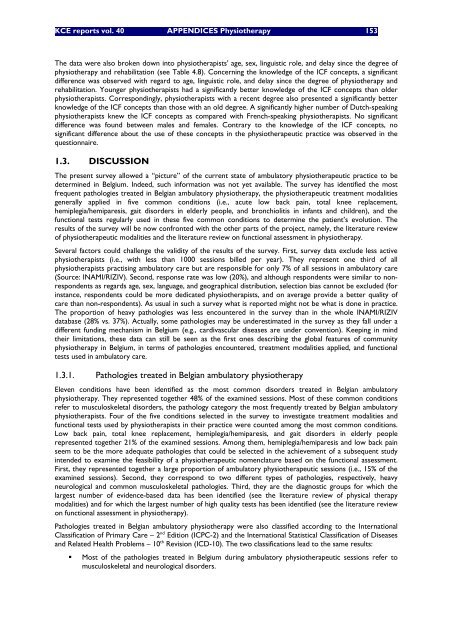Download the supplement (208 p.) - KCE
Download the supplement (208 p.) - KCE
Download the supplement (208 p.) - KCE
You also want an ePaper? Increase the reach of your titles
YUMPU automatically turns print PDFs into web optimized ePapers that Google loves.
<strong>KCE</strong> reports vol. 40 APPENDICES Physio<strong>the</strong>rapy 153<br />
The data were also broken down into physio<strong>the</strong>rapists age, sex, linguistic role, and delay since <strong>the</strong> degree of<br />
physio<strong>the</strong>rapy and rehabilitation (see Table 4.8). Concerning <strong>the</strong> knowledge of <strong>the</strong> ICF concepts, a significant<br />
difference was observed with regard to age, linguistic role, and delay since <strong>the</strong> degree of physio<strong>the</strong>rapy and<br />
rehabilitation. Younger physio<strong>the</strong>rapists had a significantly better knowledge of <strong>the</strong> ICF concepts than older<br />
physio<strong>the</strong>rapists. Correspondingly, physio<strong>the</strong>rapists with a recent degree also presented a significantly better<br />
knowledge of <strong>the</strong> ICF concepts than those with an old degree. A significantly higher number of Dutch-speaking<br />
physio<strong>the</strong>rapists knew <strong>the</strong> ICF concepts as compared with French-speaking physio<strong>the</strong>rapists. No significant<br />
difference was found between males and females. Contrary to <strong>the</strong> knowledge of <strong>the</strong> ICF concepts, no<br />
significant difference about <strong>the</strong> use of <strong>the</strong>se concepts in <strong>the</strong> physio<strong>the</strong>rapeutic practice was observed in <strong>the</strong><br />
questionnaire.<br />
1.3. DISCUSSION<br />
The present survey allowed a picture of <strong>the</strong> current state of ambulatory physio<strong>the</strong>rapeutic practice to be<br />
determined in Belgium. Indeed, such information was not yet available. The survey has identified <strong>the</strong> most<br />
frequent pathologies treated in Belgian ambulatory physio<strong>the</strong>rapy, <strong>the</strong> physio<strong>the</strong>rapeutic treatment modalities<br />
generally applied in five common conditions (i.e., acute low back pain, total knee replacement,<br />
hemiplegia/hemiparesis, gait disorders in elderly people, and bronchiolitis in infants and children), and <strong>the</strong><br />
functional tests regularly used in <strong>the</strong>se five common conditions to determine <strong>the</strong> patient s evolution. The<br />
results of <strong>the</strong> survey will be now confronted with <strong>the</strong> o<strong>the</strong>r parts of <strong>the</strong> project, namely, <strong>the</strong> literature review<br />
of physio<strong>the</strong>rapeutic modalities and <strong>the</strong> literature review on functional assessment in physio<strong>the</strong>rapy.<br />
Several factors could challenge <strong>the</strong> validity of <strong>the</strong> results of <strong>the</strong> survey. First, survey data exclude less active<br />
physio<strong>the</strong>rapists (i.e., with less than 1000 sessions billed per year). They represent one third of all<br />
physio<strong>the</strong>rapists practising ambulatory care but are responsible for only 7% of all sessions in ambulatory care<br />
(Source: INAMI/RIZIV). Second, response rate was low (20%), and although respondents were similar to nonrespondents<br />
as regards age, sex, language, and geographical distribution, selection bias cannot be excluded (for<br />
instance, respondents could be more dedicated physio<strong>the</strong>rapists, and on average provide a better quality of<br />
care than non-respondents). As usual in such a survey what is reported might not be what is done in practice.<br />
The proportion of heavy pathologies was less encountered in <strong>the</strong> survey than in <strong>the</strong> whole INAMI/RIZIV<br />
database (28% vs. 37%). Actually, some pathologies may be underestimated in <strong>the</strong> survey as <strong>the</strong>y fall under a<br />
different funding mechanism in Belgium (e.g., cardivascular diseases are under convention). Keeping in mind<br />
<strong>the</strong>ir limitations, <strong>the</strong>se data can still be seen as <strong>the</strong> first ones describing <strong>the</strong> global features of community<br />
physio<strong>the</strong>rapy in Belgium, in terms of pathologies encountered, treatment modalities applied, and functional<br />
tests used in ambulatory care.<br />
1.3.1. Pathologies treated in Belgian ambulatory physio<strong>the</strong>rapy<br />
Eleven conditions have been identified as <strong>the</strong> most common disorders treated in Belgian ambulatory<br />
physio<strong>the</strong>rapy. They represented toge<strong>the</strong>r 48% of <strong>the</strong> examined sessions. Most of <strong>the</strong>se common conditions<br />
refer to musculoskeletal disorders, <strong>the</strong> pathology category <strong>the</strong> most frequently treated by Belgian ambulatory<br />
physio<strong>the</strong>rapists. Four of <strong>the</strong> five conditions selected in <strong>the</strong> survey to investigate treatment modalities and<br />
functional tests used by physio<strong>the</strong>rapists in <strong>the</strong>ir practice were counted among <strong>the</strong> most common conditions.<br />
Low back pain, total knee replacement, hemiplegia/hemiparesis, and gait disorders in elderly people<br />
represented toge<strong>the</strong>r 21% of <strong>the</strong> examined sessions. Among <strong>the</strong>m, hemiplegia/hemiparesis and low back pain<br />
seem to be <strong>the</strong> more adequate pathologies that could be selected in <strong>the</strong> achievement of a subsequent study<br />
intended to examine <strong>the</strong> feasibility of a physio<strong>the</strong>rapeutic nomenclature based on <strong>the</strong> functional assessment.<br />
First, <strong>the</strong>y represented toge<strong>the</strong>r a large proportion of ambulatory physio<strong>the</strong>rapeutic sessions (i.e., 15% of <strong>the</strong><br />
examined sessions). Second, <strong>the</strong>y correspond to two different types of pathologies, respectively, heavy<br />
neurological and common musculoskeletal pathologies. Third, <strong>the</strong>y are <strong>the</strong> diagnostic groups for which <strong>the</strong><br />
largest number of evidence-based data has been identified (see <strong>the</strong> literature review of physical <strong>the</strong>rapy<br />
modalities) and for which <strong>the</strong> largest number of high quality tests has been identified (see <strong>the</strong> literature review<br />
on functional assessment in physio<strong>the</strong>rapy).<br />
Pathologies treated in Belgian ambulatory physio<strong>the</strong>rapy were also classified according to <strong>the</strong> International<br />
Classification of Primary Care 2 nd Edition (ICPC-2) and <strong>the</strong> International Statistical Classification of Diseases<br />
and Related Health Problems 10 th Revision (ICD-10). The two classifications lead to <strong>the</strong> same results:<br />
Most of <strong>the</strong> pathologies treated in Belgium during ambulatory physio<strong>the</strong>rapeutic sessions refer to<br />
musculoskeletal and neurological disorders.
















